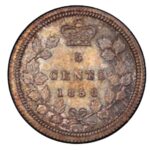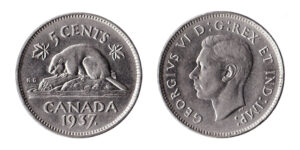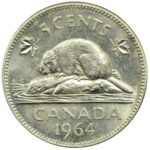Last updated on August 30th, 2024 at 12:49 pm
Last Updated on August 30, 2024 Posted by Colonial Acres Coins
Exploring the excitement and intrigue behind coin collecting can become both a passion and a profession. At Colonial Acres Coins, we believe in sharing our knowledge and expertise to help you build a collection that tells the rich history of Canada through its currency. Our dedicated team of numismatists is here to guide you through every step of your collecting journey, ensuring you have access to the most accurate information and rarest finds.
In this blog, we’re focusing on the diverse varieties of the Canadian five-cent coins, also known as nickels, and their significance for collectors. These nickels represent the evolution of Canadian currency and reflect pivotal moments in the nation’s history, from commemorative designs to changes in metal composition.
Among the rare and valuable Canadian five cent coins, collectors learn about gems such as the 1921 ‘Prince of Canadian Nickels,’ renowned for its scarcity and high auction prices, and The “Victory nickel,” minted from 1943 to 1945, was Canada’s first non-standard circulating coin aside from commemorative dollars.
We will look into the history and significance of these and more notable coins, providing insights into their origins, designs, and the reasons they are so highly prized in the numismatic community.
The Historical Significance of Canadian Five Cent Coins
The first five cent coin was minted in 1858, during a period of monetary transition and national consolidation. Crafted from sterling silver, these early coins bore the image of Queen Victoria, reflecting the strong ties Canada still had with the British Empire. The introduction of the five cent coin marked a significant step in defining Canada’s monetary identity and laid the groundwork for the diverse and historically rich numismatic landscape that collectors cherish today.
The first Canadian five-cent coins were minted in England and featured Queen Victoria on the obverse. These early coins were made of sterling silver and had a small diameter compared to modern nickels. Over the years, the design and composition of the five cent coin have undergone several changes, reflecting the country’s growth and technological advancements.
In 1922, Canada shifted from silver to nickel for its five cent coins, marking the beginning of the “nickel” era. This change was driven by the need for a more durable and cost-effective material. The introduction of nickel coins brought about new designs and features, making them a popular choice among collectors.
Recent Developments in Canadian Nickel Design
In the past couple of decades, the design of Canadian five cent coins has continued to evolve, showcasing the nation’s history and heritage. One notable change occurred in 2001, when the Royal Canadian Mint introduced a new alloy composition of 94.5% steel, 3.5% copper, and 2% nickel. This shift was generally motivated by the economic advantages of using these materials.
In terms of design, the nickel in the key year of 2005 stands out as it marked the 60th anniversary of the end of World War II. The commemorative coin featured a special “Victory” torch design, differing from the standard beaver image that had been prevalent since 1937.
Additionally, in 2013, Canada transitioned to using multi-ply plated steel for the production of its nickels, further enhancing the coin’s durability and reducing costs. These recent changes reflect an ongoing commitment to innovation and efficiency while preserving the rich cultural symbols that make Canadian currency unique.
Iconic Designs and Commemorative Editions
Canadian five cent coins have showcased a variety of designs and special commemorative editions over the years. Each design tells a unique story and highlights significant aspects of Canada’s heritage.
1858 5-Cent Coin Varieties
 Among the most intriguing early Canadian five cent coins are the six varieties of the 1858 edition. These varieties are the result of subtle differences in the minting process and include distinctions in the alignment of the date, the size of the digits, and the spacing between the letters.
Among the most intriguing early Canadian five cent coins are the six varieties of the 1858 edition. These varieties are the result of subtle differences in the minting process and include distinctions in the alignment of the date, the size of the digits, and the spacing between the letters.
Collectors refer to these varieties as the ‘Large Date’ and ‘Small Date,’ with further subcategories based on specific die characteristics.
For example, the ‘Large Date, Narrow 8’ features a smaller gap between the digits, creating a densely packed appearance, whereas the ‘Small Date, Wide 8’ displays wider spaces. Another sought-after variety is the ‘Repunched Date,’ where traces of a previous date are visible due to re-engraving errors.
Each of these varieties provides collectors with an opportunity to delve deeper into the nuances of early Canadian coinage, making the 1858 five cent pieces a fascinating study.
The 1909 and 1910 Reverse Variety: Pointed and Rounded Leaves
One of the intriguing aspects of the 1909 and 1910 Canadian five cent coins lies in the reverse variety known as the pointed and rounded leaves. These varieties are distinguished by the shape of the maple leaves on the reverse side of the coin. The pointed leaves series features sharply defined leaf tips, creating a distinct and angular appearance. In contrast, the rounded leaves variety has softly contoured leaf tips, providing a more curved and less pronounced look.
Collectors find these differences fascinating as they reflect subtle changes in the minting process during these years. The pointed and rounded leaves varieties offer an additional dimension to the study of early Canadian nickels, giving numismatists an opportunity to explore the nuances of design and production techniques in the early 20th century.
The Introduction of the Beaver Design in 1937
 The iconic beaver design was introduced on the Canadian five cent nickel in 1937, becoming a lasting symbol of Canada’s natural heritage and industrious spirit. Designed by renowned artist G.E. Kruger-Gray, the image of the beaver carefully building its dam reflects attributes highly regarded in Canadian culture, such as hard work, perseverance, and resourcefulness. This design replaced the two maple leaves and large bold Five 5 Cents in writing, aligning with a broader movement towards featuring more uniquely Canadian symbols on national currency. The beaver design has remained largely unchanged since its introduction, underscoring its significance and enduring appeal among both the general public and coin collectors alike.
The iconic beaver design was introduced on the Canadian five cent nickel in 1937, becoming a lasting symbol of Canada’s natural heritage and industrious spirit. Designed by renowned artist G.E. Kruger-Gray, the image of the beaver carefully building its dam reflects attributes highly regarded in Canadian culture, such as hard work, perseverance, and resourcefulness. This design replaced the two maple leaves and large bold Five 5 Cents in writing, aligning with a broader movement towards featuring more uniquely Canadian symbols on national currency. The beaver design has remained largely unchanged since its introduction, underscoring its significance and enduring appeal among both the general public and coin collectors alike.
Unique Features and Rare Varieties
Certain Canadian five cent coins stand out due to their unique features, errors, or rare mint marks. These attributes significantly enhance their value and appeal to collectors. For instance, some coins may have double die errors, where the design appears doubled, making them highly sought after. Others may possess mint marks from less common mints, adding to their rarity.

-
-
-
-
- 1951 High Relief: This rare variety of the 1951 nickel is notable for its high relief design, which made the coin’s elements stand out more prominently. This feature was not used extensively due to the increased wear it caused on the minting dies, making these coins sought after by collectors.
- 1947 5 Cent Varieties: In 1947, after India gained independence from British rule, Canadian coins needed to reflect the change in the King’s title. Three reverse varieties exist for the 1947 five-cent coins: Plain, Maple Leaf, and Dot. The Plain variety had no additional features. The Maple Leaf was introduced beside the year in an emergency production to distinguish it from the coins minted in early 1948. The Dot also made an appearance beside the year.
-
-
-
- 1964 Extra Water Line: This variety is distinguished by an additional line in the water behind the beaver on the reverse side of the coin. It is believed to be the result of a die crack, making it a curious error for numismatists.
- 1925 Near 6: In this rare version of the 1925 nickel, the ‘6’ in the date appears closer to the ‘2’ compared to standard issues. This misalignment adds to its rarity and desirability.
- 1936 Dot: This particular nickel was minted during King Edward VIII’s abdication crisis, and features a small dot below the date. Only a few of these coins were ever made, making them extremely rare and valuable.
These unique coins give collectors insight into the nuances and surprises of Canadian numismatic history, making them sought-after pieces in any collection.
Starting Your Collection
If you’re new to collecting coins, there are a few steps to get you started on the right path. At Colonial Acres Coins, we offer guidance and resources to help you build a meaningful and rewarding collection.
Begin by educating yourself about the different varieties of Canadian nickels and their historical context. Understanding the significance of each coin will enhance your appreciation and help you make informed decisions when acquiring new pieces.
Staying in the know about the latest offerings and events at Colonial Acres Coins is pivotal for any dedicated coin collector. We host Blowout Specials every other Friday at 2pm, where you’ll find incredible deals on a variety of coins and collectibles. Additionally, our live auctions throughout the month present a fantastic opportunity to bid on rare and unique items that may otherwise be hard to come by.
To ensure you never miss out on these exciting events, sign up for our mailing list. By subscribing, you will receive timely updates on all our special events, promotions, and auctions, allowing you to plan and participate effectively.
Elevate Your Coin Journey With Colonial
Starting your coin collection with Canadian five cent coins provides an excellent foundation, but the world of numismatics offers much more to explore. As you become more experienced, consider expanding your collection to include other world coins, commemorative editions, and even paper money. Each piece has its own story and brings a unique touch to your growing collection.
Whether it’s the historical narrative embedded in a WWII-era coin or the intricate designs of notes from various countries, diversifying your collection can enhance both its value and your appreciation for the global tapestry of currency. At Colonial Acres Coins, we are committed to supporting you every step of the way, providing the knowledge, resources, and opportunities you need to build a truly remarkable and varied collection.
If you’re serious about coin collecting, it’s important to take measures to protect your investment. Proper storage and preservation are crucial to maintaining the value of your coin collection. Use coin holders, albums, or cases to protect your nickels from damage and environmental factors. Regularly inspect and clean your coins to ensure they remain in pristine condition.
At Colonial Acres Coins, we’re passionate about helping you expand your collection with quality coins and expert advice. Explore our wide range of products and discover the rich history embedded in each piece. Ready to take your collection to the next level? Visit our website today and start your numismatic journey with Colonial Acres Coins.




